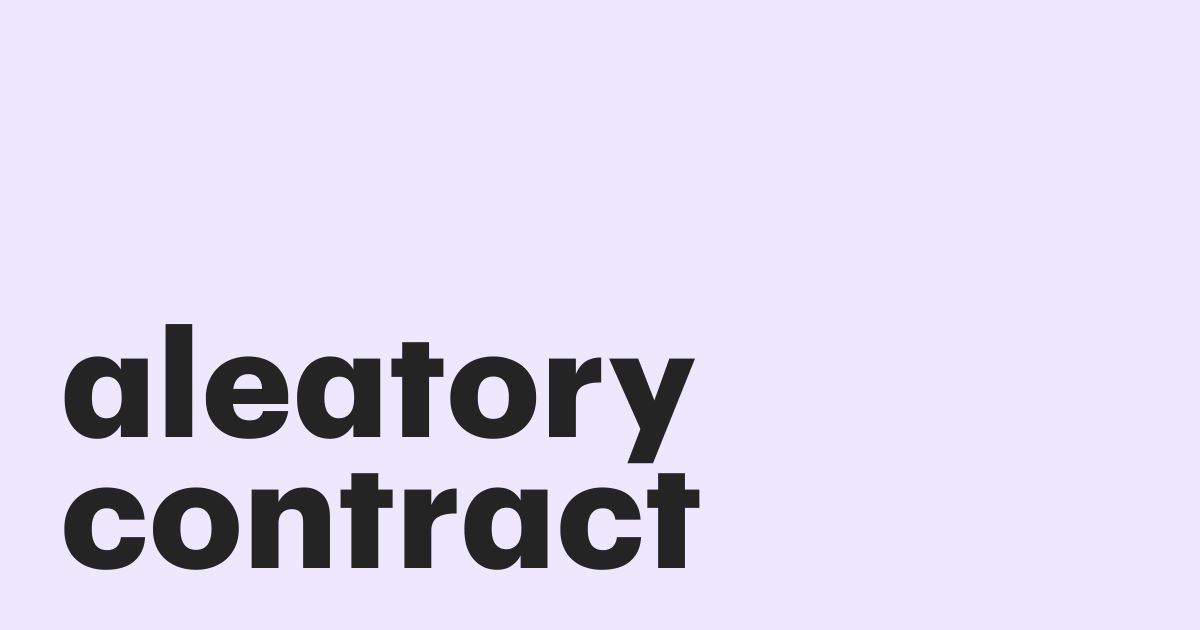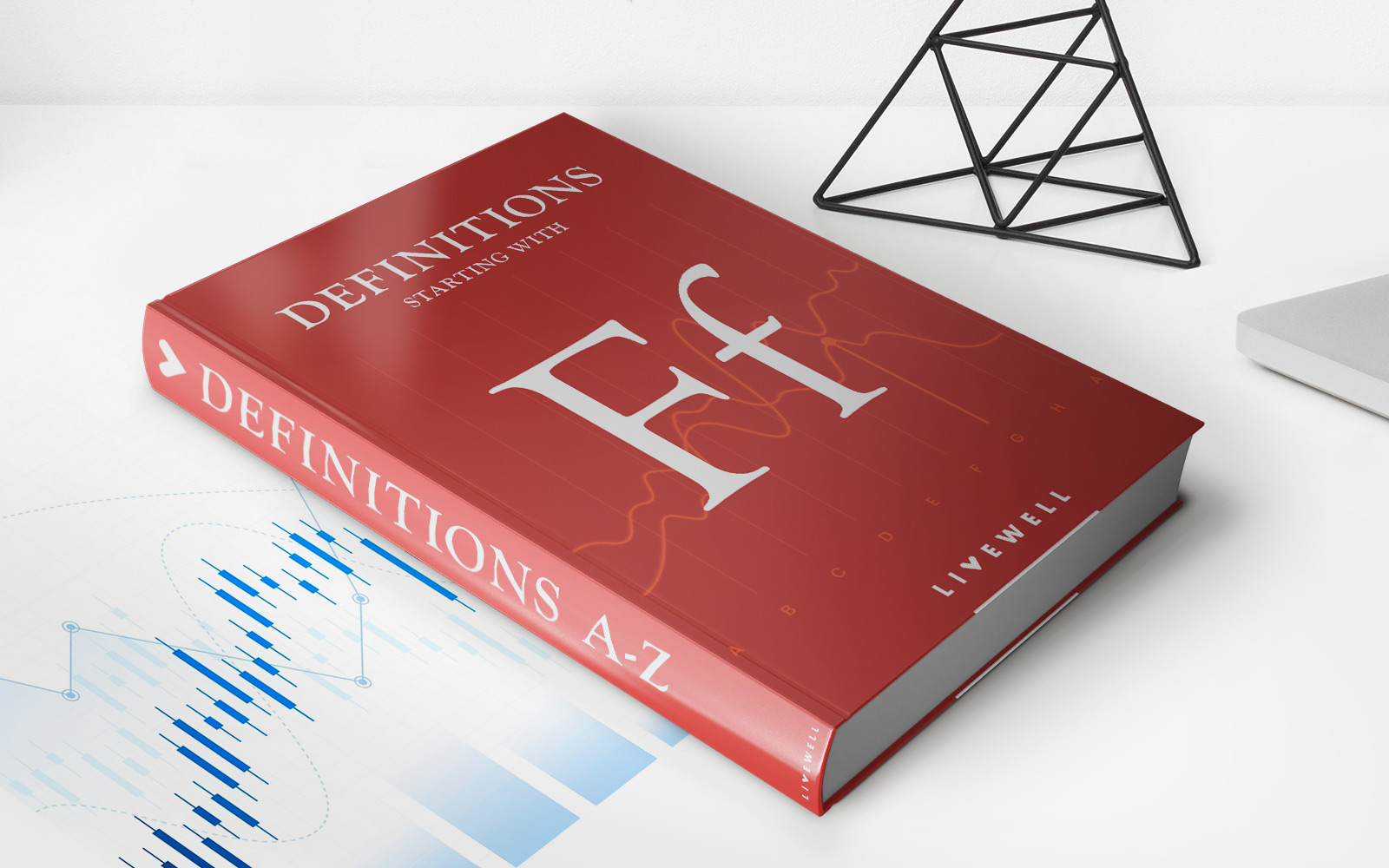

Finance
What Is An Aleatory Contract In Insurance?
Published: November 10, 2023
Learn about aleatory contracts in insurance and how they relate to finance. Understand the financial risks involved and the benefits for policyholders.
(Many of the links in this article redirect to a specific reviewed product. Your purchase of these products through affiliate links helps to generate commission for LiveWell, at no extra cost. Learn more)
Table of Contents
Introduction
In the world of insurance, there are various types of contracts that govern the relationship between the insurer and the insured. One such type is an aleatory contract, which is commonly used in the insurance industry. Aleatory contracts are unique in that they are characterized by the element of uncertainty and the unequal exchange of value between the parties involved.
An aleatory contract, also known as a gambling contract, is an agreement where the performance or outcome of the contract depends on an uncertain event or contingency. Unlike other types of contracts, where both parties exchange something of equal value, aleatory contracts involve the potential for a significant imbalance in the exchange of value.
The concept of an aleatory contract stems from the Latin word “alea,” which means dice or game of chance. The essence of an aleatory contract is that the performance or benefits derived from the contract are contingent on an uncertain future event, such as an accident, a natural disaster, or the occurrence of a specified condition.
In this article, we will explore the definition and characteristics of an aleatory contract in insurance, how they work, and the advantages and disadvantages associated with them. We will also delve into some examples of aleatory contracts in the insurance industry to provide a better understanding of their practical application.
Definition of Aleatory Contract in Insurance
An aleatory contract in insurance refers to a type of agreement where the performance or benefits received by the parties involved are dependent on the occurrence of an uncertain event. Unlike other types of contracts that are based on a predetermined set of conditions and an equal exchange of value, aleatory contracts in insurance are rooted in the principle of chance and the potential for unequal outcomes.
In an aleatory contract, the policyholder pays a premium to the insurance company in exchange for potential financial protection or compensation in the event of a specified loss or occurrence. The insurance company, in turn, assumes the risk associated with providing coverage and commits to paying the agreed-upon benefits if the specified event happens. The key aspect of an aleatory contract is that the final outcome and the value exchanged between the parties are uncertain and contingent on the occurrence of the specified event.
Insurance policies, such as life insurance, property insurance, and liability insurance, often embody the characteristics of an aleatory contract. The policyholder pays premiums regularly, but the actual benefits received will depend on the occurrence of an unforeseen event, such as death, property damage, or a liability claim. In essence, the insured is gambling on the likelihood of needing insurance benefits, while the insurance company is taking on the risk of potentially paying out large sums of money.
It is important to note that aleatory contracts do not imply that one party is taking advantage of the other. Instead, they reflect the unique nature of insurance and the uncertainties inherent in the industry. Insurance companies carefully assess risks and establish premiums based on statistical analysis, ensuring that they can cover potential claims while still maintaining profitability.
The concept of aleatory contracts in insurance helps ensure that individuals and businesses can protect themselves against unexpected losses or liabilities. It allows policyholders to transfer the financial risk associated with certain events to an insurance company, providing them with peace of mind and a level of financial security.
How Aleatory Contracts Work
Aleatory contracts in insurance operate on the basis of uncertainty and the potential for unequal exchange of value. Here’s how these contracts typically work:
- Premium Payment: The policyholder agrees to pay a premium to the insurance company. The premium amount is determined based on various factors, such as the type of insurance coverage, the insured’s risk profile, and the likelihood of the specified event occurring.
- Policy Coverage: In exchange for the premium, the insurance company provides coverage against specific risks or events. This coverage can include protection against loss, damage, liability, or even death, depending on the type of insurance policy.
- Uncertain Event: The occurrence of the insured event is uncertain and beyond the control of both parties. For example, in property insurance, the insured event could be a fire, a natural disaster, or theft. In life insurance, it could be the death of the insured.
- Triggering the Contract: If the specified event occurs, the policyholder can make a claim to the insurance company to receive the agreed-upon benefits or compensation. The insurance company will assess the claim and determine the amount payable based on the terms and conditions of the policy.
- Unequal Exchange of Value: The value exchanged between the parties is often unequal. The policyholder typically pays regular premiums over a certain period, which may exceed the actual benefits received if no claim is made. However, if a claim is triggered, the benefits received can far exceed the total premiums paid.
- Probability and Risk Assessment: Insurance companies rely on statistical analysis and actuarial calculations to assess risks and determine premium rates. They consider factors such as historical data, probability models, and demographic information to anticipate losses and set premiums that allow for the payment of claims while maintaining profitability.
Overall, aleatory contracts in insurance provide a mechanism for individuals and businesses to transfer and manage their risks. They allow policyholders to protect themselves against potential financial losses arising from uncertain events, while insurance companies assume the risk and provide financial security in exchange for premiums.
Characteristics of Aleatory Contracts
Aleatory contracts in insurance possess several distinct characteristics that set them apart from other types of contracts. These characteristics highlight the unique nature of aleatory contracts and their role in managing risks. Here are some key characteristics of aleatory contracts:
- Uncertainty: Aleatory contracts are based on the principle of uncertainty. The occurrence of the specified event, upon which the performance of the contract depends, is uncertain and beyond the control of both parties. This uncertainty introduces an element of risk and potential for unequal exchange of value.
- Unequal Exchange of Value: Unlike other contracts where parties exchange something of equal value, aleatory contracts involve an unequal exchange of value. The premium paid by the policyholder may exceed the actual benefits received in the absence of a claim. However, if a claim is triggered, the benefits received can far outweigh the premiums paid.
- Dependence on Chance: Aleatory contracts depend on chance and the occurrence of an unpredictable event. The contract only becomes active and the benefits are realized if the specified event happens. The outcomes of these contracts are determined by factors outside the control of the parties involved.
- Risk Transfer: Aleatory contracts in insurance allow for the transfer of risk from the insured to the insurance company. The policyholder pays premiums to the insurer, who assumes the financial risk associated with providing coverage. In the event of a claim, the insurance company is responsible for paying out the agreed-upon benefits.
- Quantifiable Risks: Insurance companies evaluate risks and determine premium rates based on quantifiable factors, such as historical data, probability models, and actuarial calculations. This allows them to assess the potential for losses and establish premiums that reflect the level of risk involved.
These characteristics make aleatory contracts in insurance a unique and essential tool for managing risks. They provide individuals and businesses with a means to safeguard against unforeseen events and transfer the financial burden associated with those events to an insurance company. Despite the unequal exchange of value, aleatory contracts create a sense of security and financial stability by providing coverage and benefits in times of need.
Examples of Aleatory Contracts in Insurance
Aleatory contracts in insurance are prevalent in various sectors, providing coverage for a wide range of risks and events. Here are a few examples of aleatory contracts in the insurance industry:
- Life Insurance: Life insurance policies are prime examples of aleatory contracts. Policyholders pay regular premiums to the insurance company, and in the event of the insured’s death, the policyholder’s beneficiaries receive a predetermined death benefit. The amount paid in premiums over the insured’s lifetime may far exceed the death benefit received, resulting in an unequal exchange of value.
- Property Insurance: Property insurance policies cover the loss or damage to assets such as homes, buildings, or vehicles. Policyholders pay premiums to protect themselves against the risk of fire, natural disasters, theft, and other unforeseen events. If a covered event occurs, the insurance company provides compensation to cover the cost of repair, replacement, or rebuilding. The premiums paid may exceed the actual losses incurred if no claim is made, but the benefits received in the event of a covered loss can far outweigh the premiums paid.
- Liability Insurance: Liability insurance protects individuals or businesses from potential financial losses due to third-party claims or lawsuits. For example, a business may have general liability insurance to cover bodily injury or property damage caused by their operations. The policyholder pays premiums to transfer the risk of legal expenses and potential damages to the insurer. In the event of a covered claim, the insurance company bears the cost of litigation, settlements, or awards. Once again, the premiums paid may be significantly higher than the potential losses, resulting in an unequal exchange of value.
- Disability Insurance: Disability insurance provides income replacement in the event that an individual becomes disabled and is unable to work. The policyholder pays premiums to the insurance company, and if they become disabled and meet the policy’s definition of disability, they will receive regular payments or a lump sum benefit. The premiums paid may exceed the disability benefit if no claim is made, but the financial protection provided during a period of disability can be invaluable.
- Travel Insurance: Travel insurance offers coverage for risks such as trip cancellation or interruption, medical emergencies, lost luggage, and other unforeseen events that can occur while traveling. Policyholders pay premiums to the insurance company, and if a covered event occurs during their trip, they can receive reimbursement for the incurred expenses. Once again, the premiums paid may exceed the actual benefits received, but the financial protection and peace of mind provided during travel are important considerations for many individuals.
These examples illustrate the workings of aleatory contracts in insurance, highlighting the element of uncertainty and unequal exchange of value. Insurance policies allow individuals and businesses to proactively manage potential risks and provide financial protection against unforeseen events, contributing to greater peace of mind and security.
Advantages of Aleatory Contracts
Aleatory contracts in the insurance industry offer several advantages for both policyholders and insurance companies. Here are some key advantages of aleatory contracts:
- Financial Protection: Aleatory contracts provide individuals and businesses with financial protection against unforeseen events and risks. Policyholders can transfer the potential financial burden of losses or liabilities to an insurance company, reducing their exposure to financial hardships.
- Peace of Mind: Aleatory contracts in insurance bring peace of mind to policyholders. Knowing that they are protected against specific risks and that there is a financial safety net in place gives individuals and businesses a sense of security and confidence in managing uncertainties.
- Risk Management: Aleatory contracts allow policyholders to effectively manage risk. By transferring the potential financial risk associated with specific events to an insurance company, individuals and businesses can focus on their core activities without the constant worry of substantial financial losses.
- Pooling of Resources: Aleatory contracts promote the pooling of resources. Insurance companies collect premiums from a large number of policyholders, enabling them to build a pool of funds to manage claims and provide benefits when needed. This spreading of risk across a larger group allows for the payment of claims without causing significant financial strain on any individual policyholder.
- Access to Expertise: Insurance companies possess expertise in assessing and managing risks. Policyholders benefit from the knowledge and experience of insurance professionals who can accurately evaluate risk levels, set appropriate premiums, and provide guidance and advice on risk mitigation strategies.
These advantages demonstrate why aleatory contracts are widely utilized in the insurance industry. They provide a mechanism for individuals and businesses to mitigate and manage risks, ensuring that they are financially protected against unforeseen events and uncertainties. Aleatory contracts play a crucial role in providing peace of mind, enabling risk management, and facilitating the efficient pooling of resources to ensure the availability of funds when claims occur.
Disadvantages of Aleatory Contracts
While aleatory contracts in insurance offer various advantages, they also come with a few disadvantages that should be considered. Here are some potential drawbacks of aleatory contracts:
- Unequal Exchange of Value: One of the main criticisms of aleatory contracts is the potential for an unequal exchange of value. Policyholders may pay premiums for extended periods without ever making a claim, resulting in a perceived loss of the value of their premiums. This mismatch between premiums paid and benefits received can lead to feelings of dissatisfaction or resentment.
- High Premiums: Aleatory contracts, particularly in high-risk areas or for policies with extensive coverage, can result in high premiums for policyholders. The insurance company must account for the potential for significant claims, which can drive up the cost of coverage. This can make insurance less accessible or affordable for some individuals or businesses.
- Dependence on Insurance Companies: Policyholders in aleatory contracts are dependent on the insurance company’s financial stability and ability to pay claims. In the event of a major catastrophe or economic downturn, an insurance company may face financial difficulties, potentially impacting its ability to honor policyholder claims. Policyholders must carefully select reputable and financially secure insurers to mitigate this risk.
- Limited Coverage: Aleatory contracts may come with certain limitations, exclusions, or conditions that restrict the scope of coverage. These limitations may affect the policyholder’s ability to claim benefits in certain situations, resulting in potential gaps in coverage that were not anticipated or understood at the time of policy purchase.
- Complex Policy Terms: Some aleatory insurance contracts can have complex terms, conditions, and exclusions that can be difficult for policyholders to comprehend fully. Misunderstandings or misinterpretations of policy terms may result in unexpected claim denials or disputes.
It is important for individuals and businesses to carefully consider the potential disadvantages of aleatory contracts in insurance and weigh them against the benefits. Policyholders should thoroughly review policy terms, understand the coverage and limitations, and select reputable insurance providers to ensure they receive adequate protection and minimize potential drawbacks.
Risks Associated with Aleatory Contracts
While aleatory contracts in insurance provide valuable protection against uncertain events, they also come with inherent risks that policyholders should be aware of. Here are some of the risks associated with aleatory contracts:
- Unpredictable Outcomes: Aleatory contracts involve uncertainty and dependency on unpredictable events. This means that the ultimate outcome and financial benefits of the contract are not guaranteed. Policyholders face the risk of not receiving the expected benefits, particularly if the specified event does not occur within the policy term or the event is not covered by the contract.
- Financial Losses: In aleatory contracts, the policyholder may pay premiums over an extended period without ever making a claim. This can result in financial losses, as the total premiums paid may exceed the value of the benefits received, especially if the occurrence of the specified event is low or the policyholder is lucky enough to avoid any losses.
- Coverage Gaps: Aleatory contracts may contain limitations, exclusions, or conditions that restrict the scope of coverage. Policyholders may not fully understand these terms or the potential coverage gaps, leading to unexpected denials of claims or disputes with the insurance company. It is important to carefully review policy terms and seek clarification on any ambiguous areas before entering into the contract.
- Insolvency of Insurance Companies: In the event of an economic downturn or a catastrophic event, insurance companies may face financial difficulties or even insolvency. This poses a risk to policyholders, as they may not receive the expected benefits if the insurance company is unable to fulfill their obligations. Researching the financial stability and reputation of the insurance provider is essential to mitigate this risk.
- Inadequate Coverage: Depending on the specific terms and conditions of an aleatory contract, policyholders may find that the coverage provided is insufficient to adequately protect against potential losses or liabilities. It is crucial to carefully assess the coverage needs and ensure that the policy offers appropriate protection.
While aleatory contracts offer the potential for financial security and risk management, these risks should be carefully considered. Policyholders should thoroughly understand the terms of the contract, assess their own risk tolerance, and select reputable insurance providers to minimize the potential downsides associated with aleatory contracts in insurance.
Conclusion
Aleatory contracts in insurance play a vital role in managing risks and providing financial protection against uncertain events. These contracts are characterized by their reliance on chance and the potential for an unequal exchange of value. While they offer various advantages, such as financial security and peace of mind, they also come with disadvantages and potential risks that should be carefully considered.
Aleatory contracts allow individuals and businesses to transfer the potential financial burden of losses or liabilities to an insurance company. They provide a mechanism for pooling resources and managing risks on a larger scale. By paying premiums, policyholders gain access to expertise, financial protection, and risk management strategies provided by insurance companies.
However, there are risks associated with aleatory contracts that warrant caution. Policyholders face the possibility of not receiving the expected benefits, the potential for financial losses if premiums exceed the value of benefits, coverage gaps due to policy limitations or exclusions, and the risk of insolvency of insurance companies.
To mitigate these risks, it is crucial for individuals and businesses to thoroughly review policy terms, seek clarification on any ambiguous areas, and select reputable insurance providers with a strong financial standing. Understanding the terms, conditions, and limitations of aleatory contracts is essential for making informed decisions and selecting coverage that aligns with specific needs and risk tolerances.
In conclusion, aleatory contracts in insurance offer a valuable means of transferring and managing risk. Policyholders should carefully weigh the benefits and disadvantages, assess their own risk tolerance, and ensure they have the appropriate coverage to protect against potential losses. By understanding the nature and characteristics of aleatory contracts, individuals and businesses can make informed decisions and leverage the benefits, while mitigating the associated risks.














